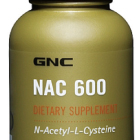 • N-acetyl cysteine is an amino acid that acts as a decongestant, boosts immune response and serves as a powerful detoxification agent. One of its key features is its ability to assist in the production of glutathione, the body’s most dynamic antioxidant and free-radical scavenger. There is evidence that this water-soluble nutrient can also help support lean muscle development.
• N-acetyl cysteine is an amino acid that acts as a decongestant, boosts immune response and serves as a powerful detoxification agent. One of its key features is its ability to assist in the production of glutathione, the body’s most dynamic antioxidant and free-radical scavenger. There is evidence that this water-soluble nutrient can also help support lean muscle development.
Researchers contend that NAC’s ability to boost glutamine in the bloodstream accounts for its ability to prevent muscle breakdown. Additionally, new information shows that NAC supports cell-volumizing activities, such as increased protein synthesis for lean-muscle development.
Kinscherf, R., et.al. (1996). Low plasma glutamine in combination with high glutamate levels indicate risk for loss of body cell mass in healthy individuals: the effect of n-acetyl cysteine. J Molec Med. 74(7):393:400.
Droge, W., et al. (1998). Role of cysteine and glutathione in signal transduction, immunopathology and cachexia. Biofactors. 8(1-2):97-102.
[Are you looking for health, muscle and the amazing anti-aging benefits of resistance training? Get the new e-book by Steve and Becky Holman, Old School, New Body. Read the Iron Man magazine review here.]
• Vanadyl sulfate is derived from the mineral vanadium and has been found to mimic the actions of insulin. It’s also revered for its ability to promote vascular pumps, adding fullness and hardness to muscles.
Vanadyl sulfate’s ability to mimic insulin also indicates that it will help drive nutrients such as protein and carb into muscle tissue much more efficiently. That was shown by a scientist who reported in the medical journal Diabetes that vanadyl sulfate has the ability to increase creatine uptake by muscle cells. That action can stimulate increase protein synthesis and cell volumization and refuel spent muscles.
Radda, G.K., et al. (1996). Control of energy metabolism during muscle contraction. Diabetes. 45(1):88-92.
• While many amino acids assist in protein synthesis, beta-alanine increases the intramuscular concentration of the amino acid carnosine, a buffering agent. During workouts, muscle pH levels decline, increasing acids that trigger inflammation and fatigue. By increasing carnosine levels in working muscles, beta-alanine can buffer muscle acidity, enabling you to extend sets for more fiber activation.
In recent studies, taking four to six grams a day for 10 weeks showed average increases of intramuscular carnosine of 58.8 percent. The results also indicate that after four weeks of beta-alanine supplementation, workload capacity increased by 13 percent, with an additional 3.2 percent improvement in resistance-trained bodybuilders. Those results clearly show that beta-alanine delays fatigue and speeds recovery.
Tallon, M.J., et. al., (2005). The carnosine content of vastus lateralis is elevated in resistance-trained bodybuilders. J Strength Cond Res. 19:725-729.
Hill, C.A., et. al. (2007). Influence of beta-alanine supplementation on skeletal muscle carnosine concentrations and high-intensity-cycling capacity. Amino Acids. 32(2):225-233.
—George L. Redmon, Ph.D.




















You must be logged in to post a comment Login